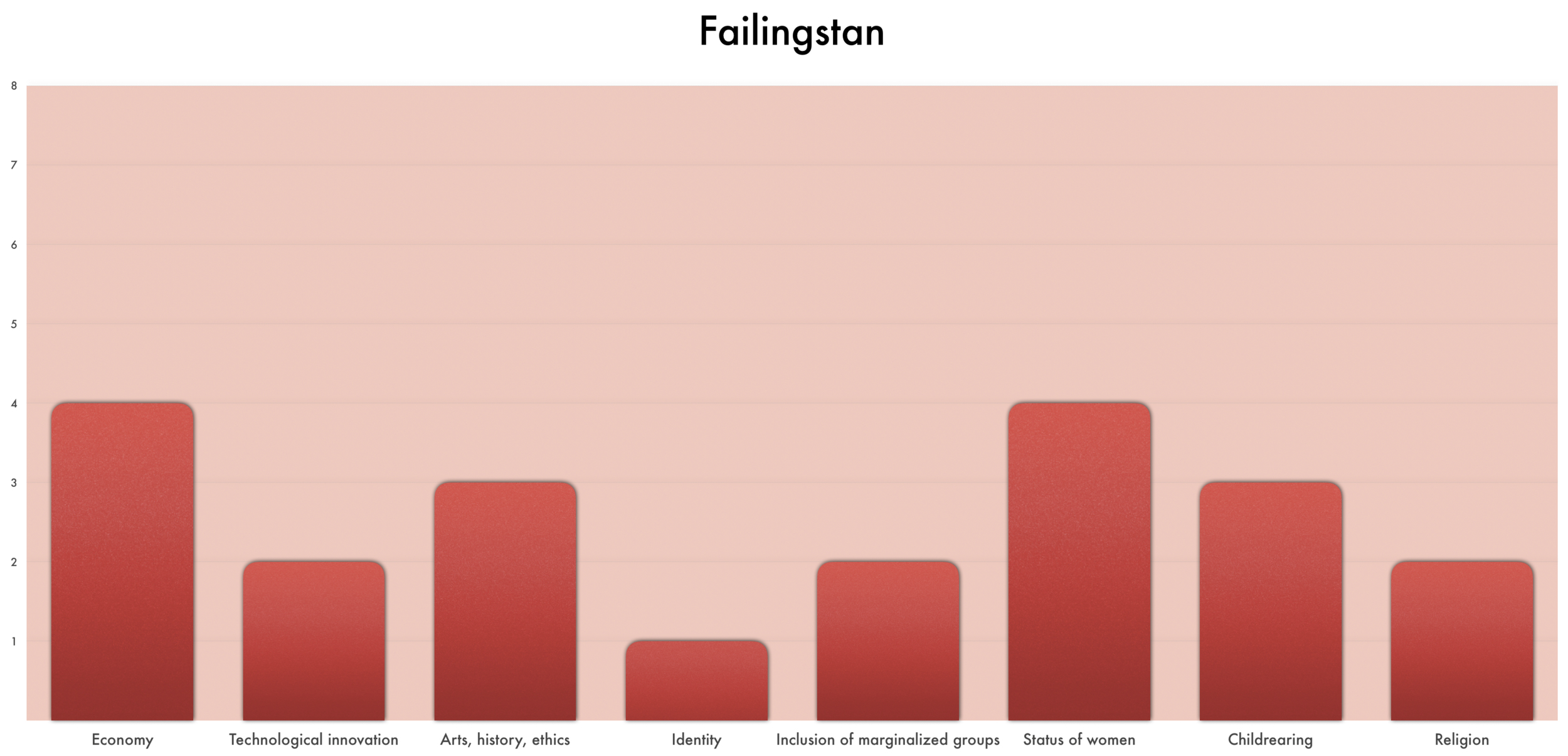How we measure resilience
The first step in building a country’s resilience is seeing the resilience as it actually is.
Cultural resilience tells us about a society’s ability to support and sustain any venture or initiative in the face of inevitable stresses and shocks. The charts below reveal 8 dimensions of Enlightenedstan’s, Developingstan’s, and Failingstan’s cultural resilience. The stronger each dimension of its culture, the more effectively the country will respond to existential threats.
Economy reveals what elements of a functional economy exist in the country.
Technological Innovation reveals the capacity of the country to solve physical problems, using science and technology.
Arts, history, and ethics reveal how engaged and informed the middle class is about their country, heritage, the world, and their responsibilities to their country.
Identity reveals how the inclusive groups are that residents of the country feel themselves belonging to: only themselves; their families, friends, gang, or profession; their village, tribe, town, or city; their ethnic group, religious group, or political party; their state, region, or province; their country; their supranational geopolitical group (e.g., the European Union); the international community as a whole
Inclusion of marginalized groups reveals how included and enfranchised residents are who live outside the mainstream of the country’s society.
Status of women reveals how much freedom, opportunity, and control the country’s women have over their own lives, and how much they can contribute to helping other citizens and their society.
Childrearing reveals the capacity of the population for empathy, impulse control, rational thought, and moral sense.
Religion reveals the capacity of the country’s public for altruism and cooperation.
As seen above, Enlightenedstan ranks 6 in Economy, 5 in Technological innovation, 7 in Art, history, ethics, 5 in Identity, 6 in Inclusion of marginalized groups, 8 in Status of women, 6 in Childrearing, and 5 in Religion.
•6 in Economy indicates that the national economy is well-regulated, with all four of these features: access to jobs and housing for all of the population, markets that incentivize inclusive growth, strong regulatory mechanisms, and predicable rules and enforcement of contracts, but not yet tested through a financial crisis.
•5 in Technological innovation indicates there are centers where people have full access to basic technology, and 3 of the 6 elements needed to create new technology: science, technology, engineering, and math education, technology workers, systemic infrastructure, entrepreneurial ecosystem, regulatory framework, massive funding to research and develop solutions to global threats.
•7 in Art, history, ethics indicates the middle class of this country regularly experiences, learns about, or discusses 7 of the 8 modes of national culture: music, theatre, or dance; painting, sculpture, television, and film; literature; national history; cultural history; world history; pre-history.
•5 in Identity indicates that residents identify most strongly with their state, region, or province.
•6 in Inclusion of marginalized groups indicates there is legal acceptance and equality for marginalized groups composed of citizens of the country.
•8 in Status of women indicates the rights of all resident women are legally and practically equivalent to those of men.
•6 in Childrearing indicates that parents encourage their children's choices for their own lives, including career and marriage.
•5 in Religion indicates there is one dominant religious community, which is tolerant of other religions and of atheists.
Investors in Enlightenedstan can rely on deep wells of human, social, financial, intellectual, and creative capital to sustain and grow their ventures.
As seen above, Developingstan ranks 4 in Economy, 6 in Technological innovation, 5 in Art, history, ethics, 3 in Identity, 2 in Inclusion of marginalized groups, 5 in Status of women, 6 in Childrearing, and 3 in Religion.
•4 in Economy indicates two of these four features exist at the national level: access to jobs and housing for all of the population, markets that incentivize inclusive growth, strong regulatory mechanisms, predicable rules and enforcement of contracts.
•6 in Technological innovation indicates there are centers where people have full access to basic technology, and 4 of the 6 elements needed to create new technology: science, technology, engineering, and math education, technology workers, systemic infrastructure, entrepreneurial ecosystem, regulatory frameworks, massive funding to research and develop solutions to global threats.
•5 in Art, history, ethics indicates the middle class of this country regularly experiences, learns about, or discusses 5 of the 8 modes of national culture: music, theatre, or dance; painting, sculpture, television, and film; literature; national history; cultural history; world history; pre-history.
•3 in Identity indicates that residents identify most strongly with their village, tribe, town, or city.
•2 in Inclusion of marginalized groups indicates that marginalized groups are protected from mass killing, but many members die from neglect.
•5 in Status of women indicates women have a legal right to education, property rights, and inheritance, but these rights are not necessarily available in practice, in which there is strong, informal discrimination against women (e.g., informal discrimination in hiring practices or salary).
•6 in Childrearing indicates that parents encourage their children's choices for their own lives, including career and marriage.
•3 in Religion indicates that the country’s religious intermediaries—priests, imams, saints, gurus, rabbis, and others—translate and explain God’s will to residents. Believers hope to have their needs met beyond the immediate life.
Investors in Developingstan can likely find significant human, social, financial, intellectual, and creative capital within individual villages, tribes, or communities, but it will be difficult for a venture to spread outside of pockets of support.
As seen above, Failingstan ranks 4 in Economy, 2 in Technological innovation, 3 in Art, history, ethics, 1 in Identity, 2 in Inclusion of marginalized groups, 4 in Status of women, 3 in Childrearing, and 2 in Religion.
•4 in Economy indicates two of these four features exist at the national level: access to jobs and housing for all of the population, markets that incentivize inclusive growth, strong regulatory mechanisms, predicable rules and enforcement of contracts.
•2 in Technological innovation indicates there are centers where people have full access to basic technology, and none of the 6 elements needed to create new technology: science, technology, engineering, and math education, technology workers, systemic infrastructure, entrepreneurial ecosystem, regulatory frameworks, or massive funding to research and develop solutions to global threats.
•3 in Art, history, ethics indicates the middle class of this country regularly experiences, learns about, or discusses 3 of the 8 modes of national culture: music, theatre, or dance; painting, sculpture, television, and film; literature; national history; cultural history; world history; pre-history; their social responsibility.
•1 in Identity indicates that residents identify most strongly only with themselves, not others.
•2 in Inclusion of marginalized groups indicates that marginalized groups are protected from mass killing, but many members die from neglect.
•4 in Status of women indicates violence against women is prohibited, but there are consistent, legally enforced, rigid social rules and expectations of women’s behavior in the home, or in society.
•3 in Childrearing indicates the country’s children are given homes and are not neglected, but children are raised in an unpredictable atmosphere, and subjected to sexual mistreatment or beating.
•2 in Religion indicates the country’s political leader or leaders control the public’s faith practices. (The leader might even be the deity.) Religion provides for needs, up to a generation. For example, “If the people are faithful we will be victorious in battle and be a safe and powerful nation state.”
Investors in Failingstan can rely on the relative competence of women and the economy, but there will be significant gaps in the human, social, intellectual, and creative capital needed to sustain and grow most ventures.
In general, more developed countries rank higher in the eight dimensions of resilience, but not always. For example, Developingstan ranks higher on technological innovation than Enlightenedstan.




